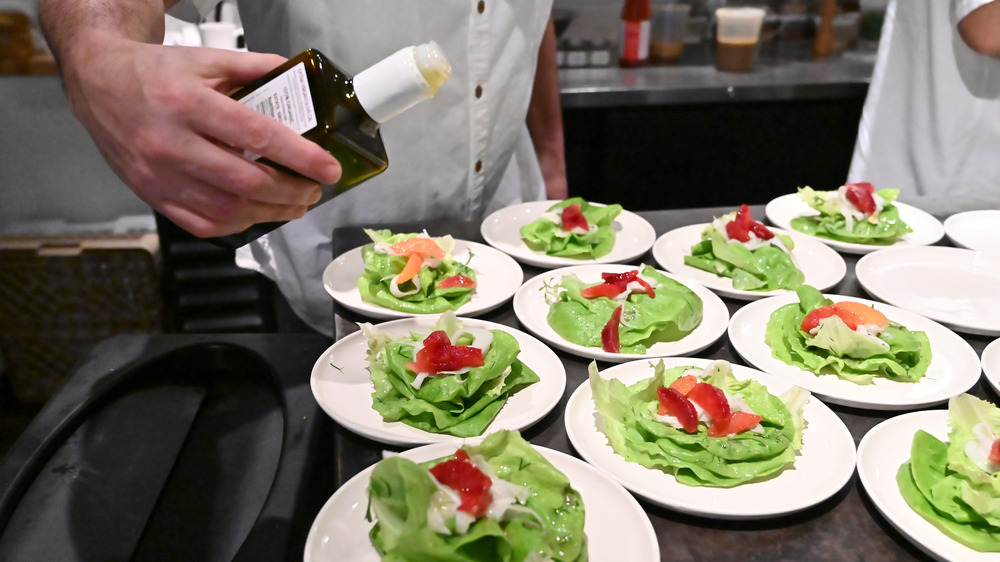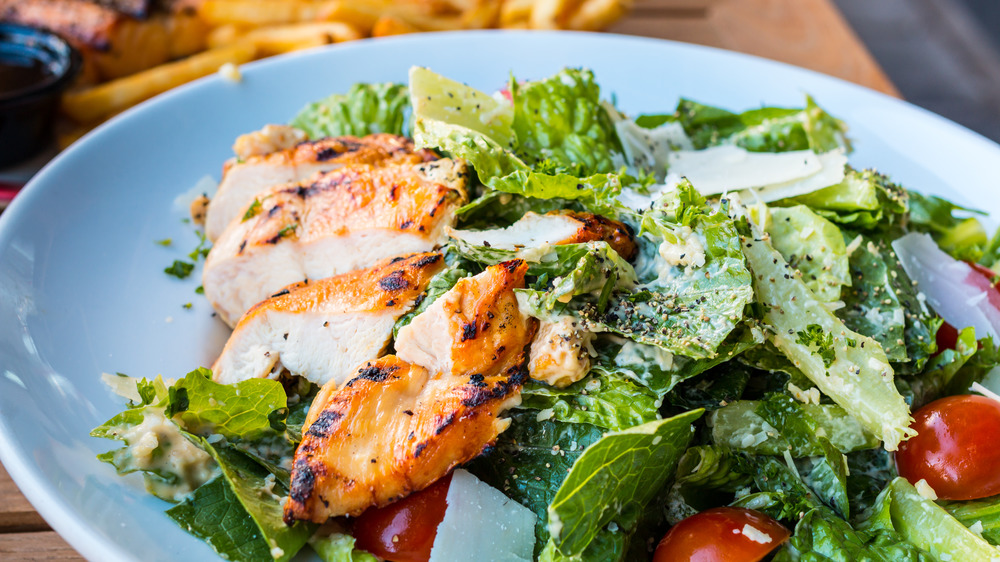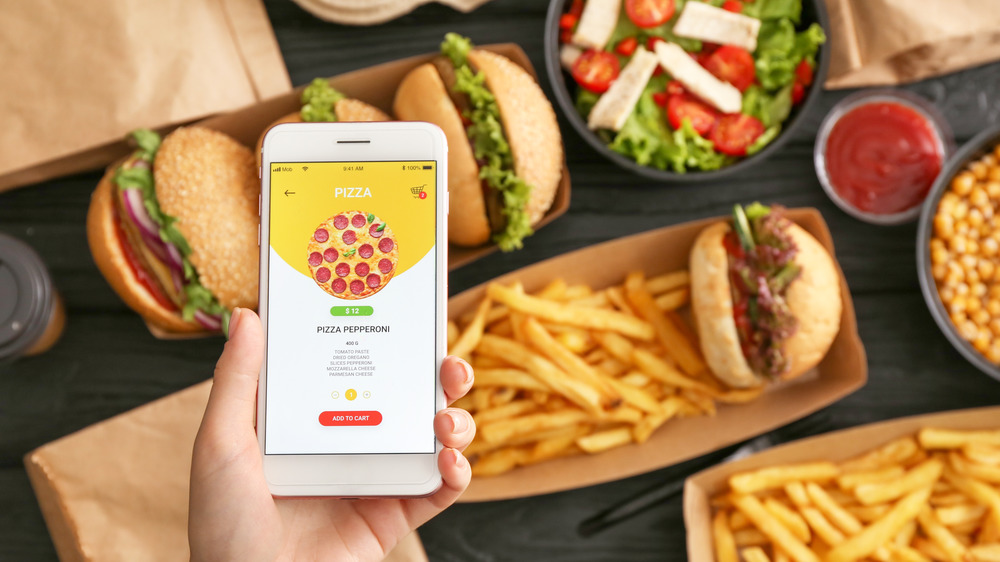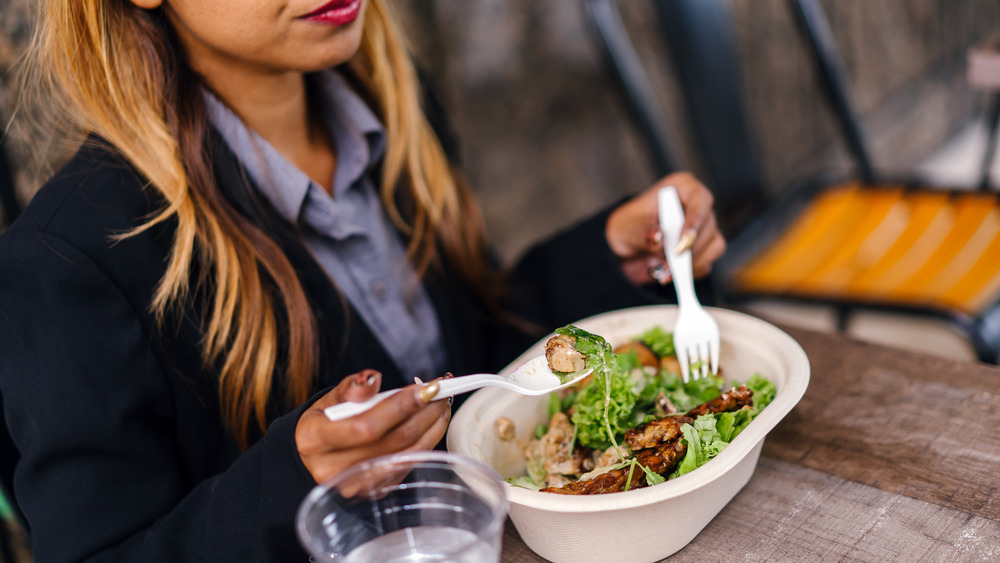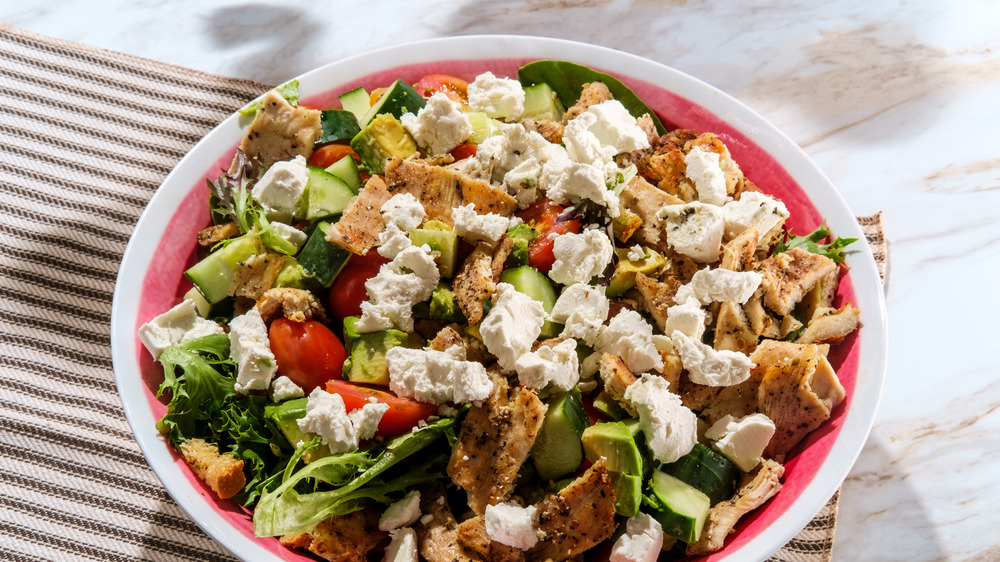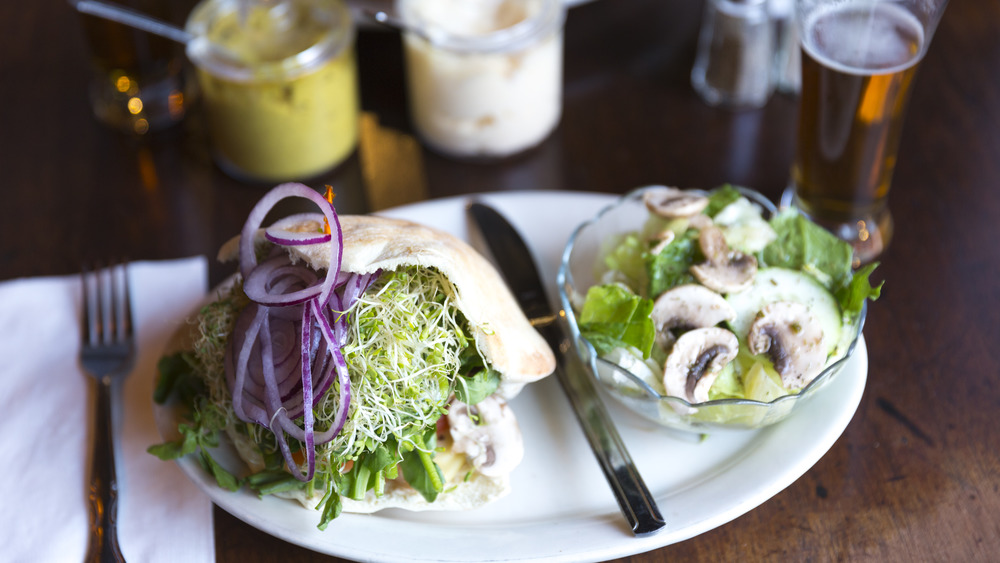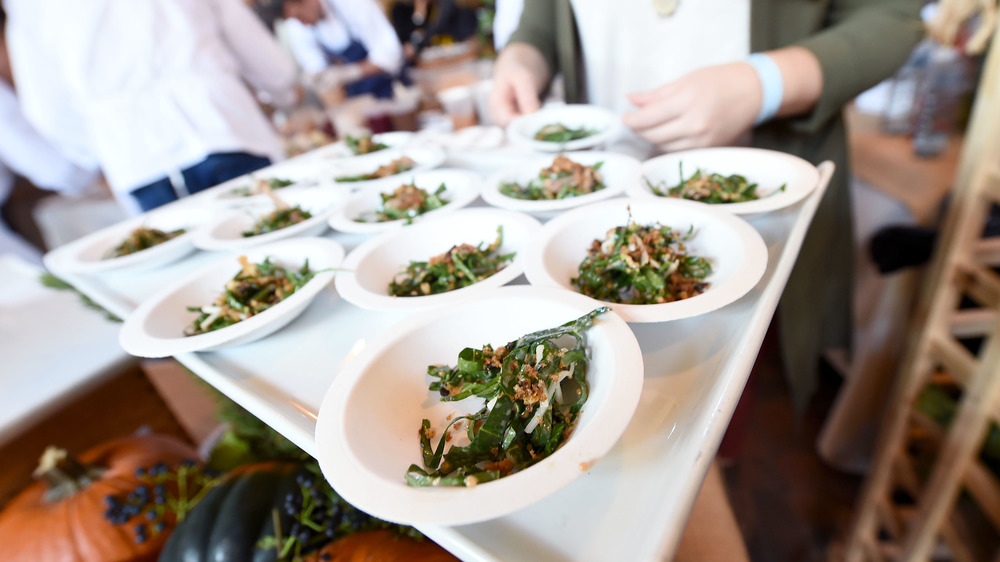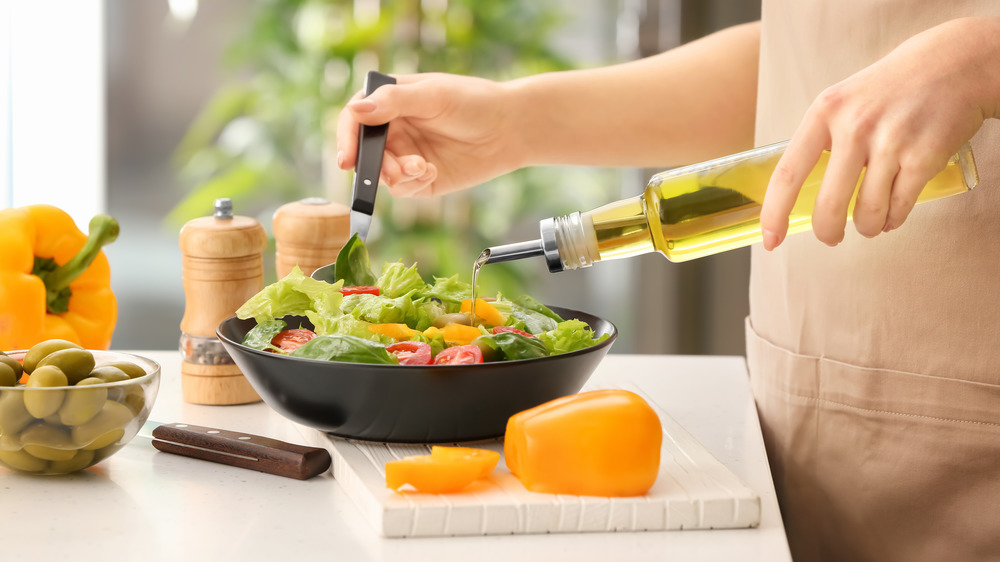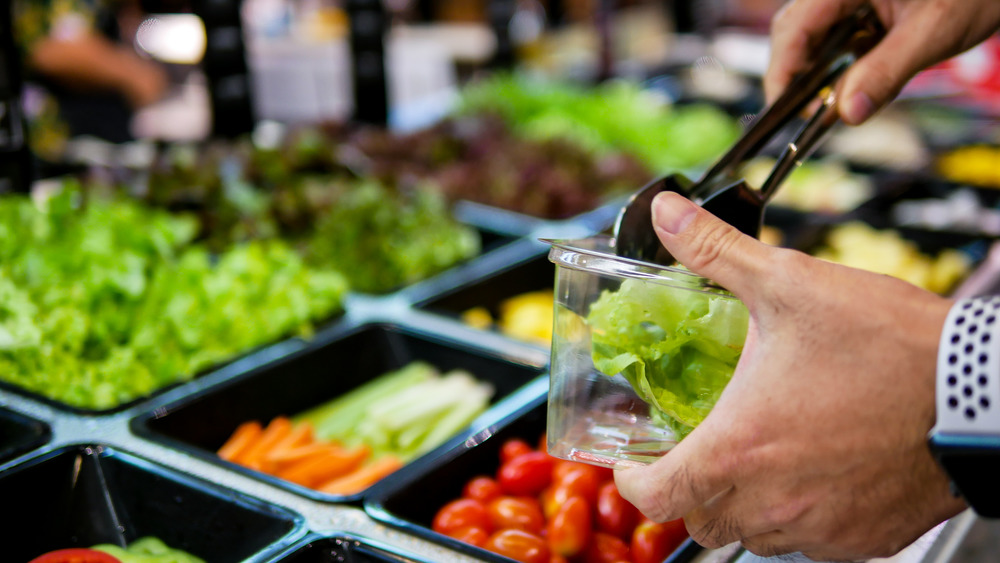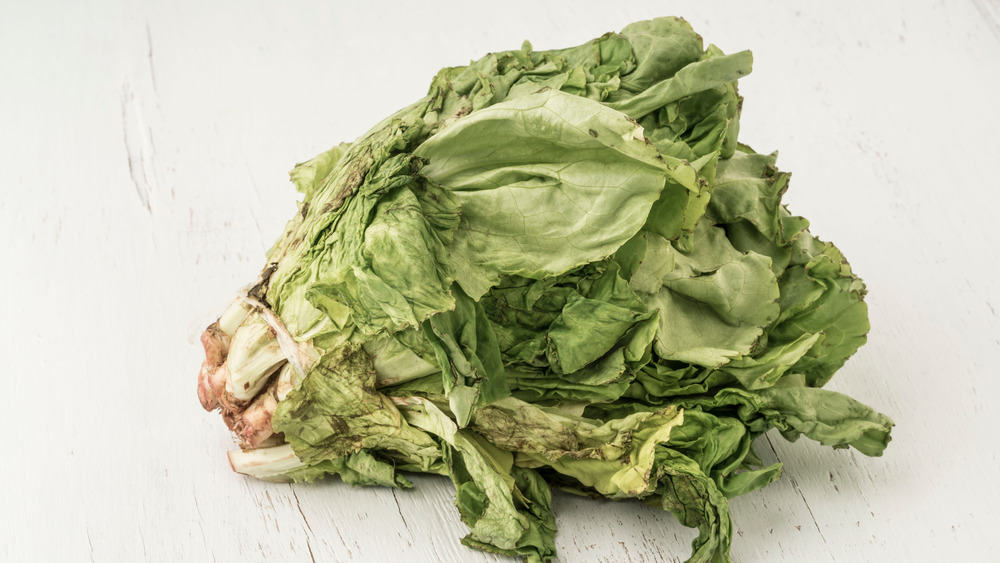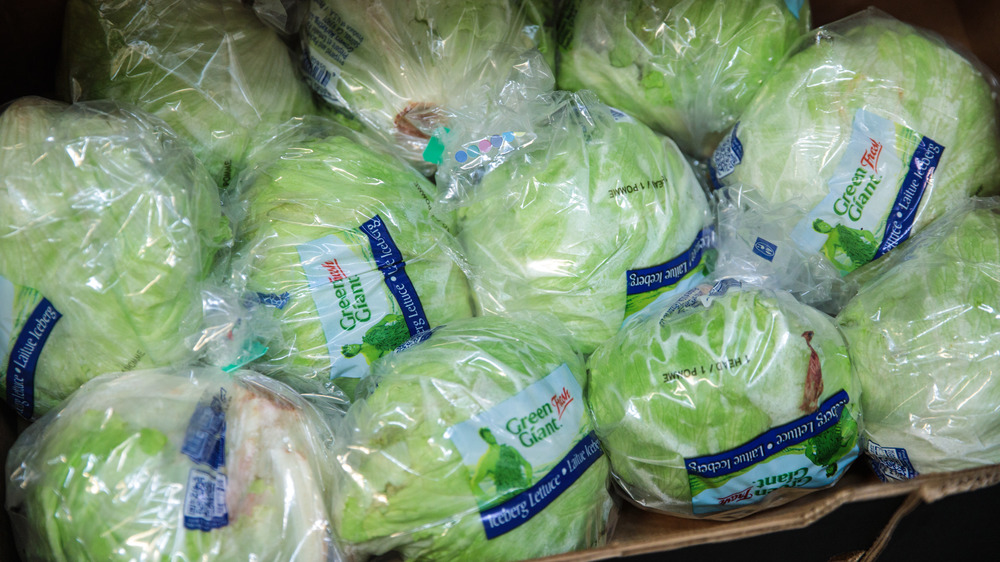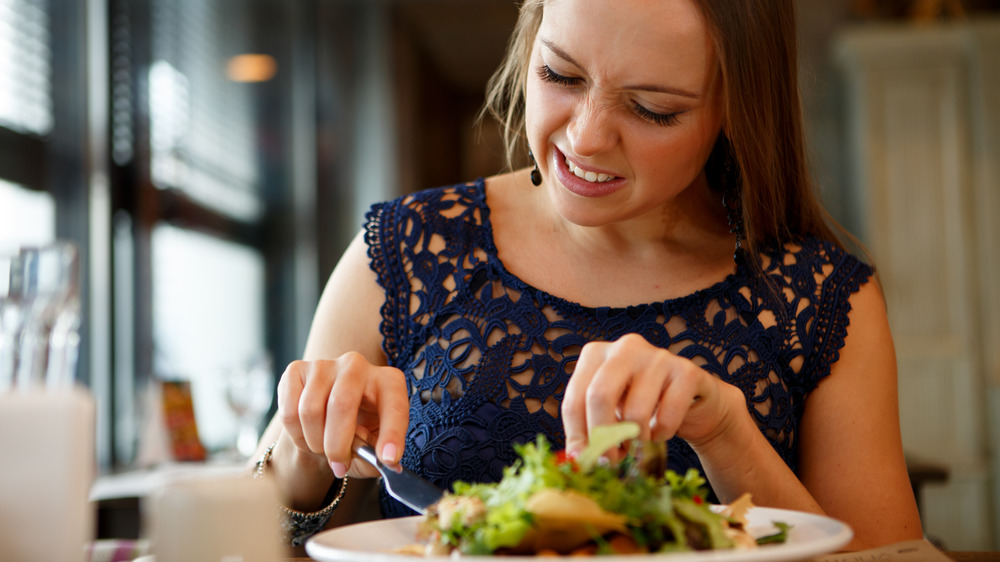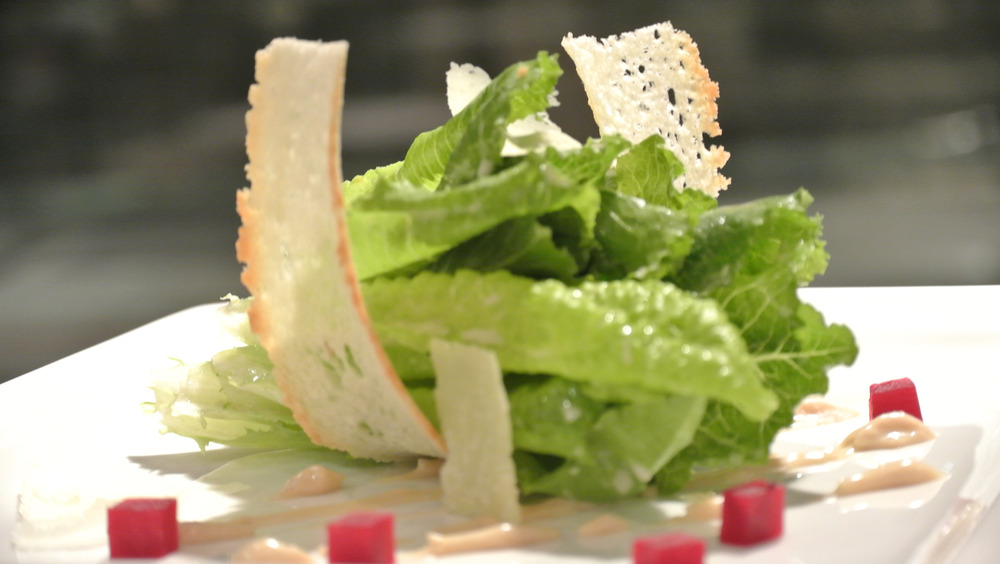Sneaky Ways Restaurants Could Be Scamming You With Salads
When you're at a restaurant scanning the menu for something healthy, where do you usually look first? Probably the salad section, right? While red meat and pasta dishes can be loaded with fat and carbs, and chicken and fish dishes can sometimes hide under fatty ingredients like sauces and crusts, salads typically seem harmless. After all, it's a pile of vegetables — what could go wrong? Likewise, if you're looking for something light and easy on the stomach, a salad seems like an agreeable option.
However, if you're looking for something healthy, light, and innocent, you may want to start steering clear of the salad section of your favorite restaurant's menu. There are many reasons why a salad might be a scam — on your health or wallet. Sometimes that healthful-looking plate of lettuce is filled with hidden calories. Sometimes that huge lunch-special salad won't actually fill you up, for more than one reason. Sometimes a restaurant is simply hiding some unsavory ingredients (dirt included) in your salad, things you'd rather stay away from.
Here are 12 sneaky ways restaurants could be scamming you with salads and how to spot the culprits. You may just decide never to order the restaurant salad again, and stick to making your own at home, while ordering the chicken or fish when you go out.
That grilled chicken on your salad? Probably not really grilled
When ordering a salad topped with chicken, you usually get two options: grilled or fried. Obviously, you probably think, the grilled chicken is healthier than the fried, so you opt for it. Your salad comes out topped with a sprinkling of sliced chicken breast, grilled to perfection, with grill marks included — or at least, that's what you think. Turns out, even if your salad chicken looks grilled, it probably isn't.
As one Fast Company article reveals, many restaurants, rather than pay someone to actually grill your chicken, which requires not only extra manpower and time, but extra equipment as well, will purchase their chicken already grilled, made possible thanks to the many chicken providers that cater to restaurants, including Tyson. But, alas, those companies aren't actually grilling your chicken either. Instead, according to The New Food Economy, they marinate the chicken and then bake it. There's no grilling at any point in the process.
If you're lucky, the restaurant might throw your chicken onto a flat top grill to heat it up before placing it on your salad, but that's not really a grill at all — it's more like a griddle.
Your salad could be just a ploy to get you to order something else
You go to a nearby restaurant knowing that they don't really offer that many healthful options, but you intend to order a salad, so you're in the clear. No worries. But when you sit down in your booth or stand in line at the counter, you find that the words that come out of your mouth are far from your intentions. Turns out, this is something restaurants have predicted you'll do and they're counting on it in order to sell you more of the bad stuff.
A 2009 study found that fast-food restaurants tap into something called vicarious goal fulfillment. Basically, it means that you don't necessarily have to accomplish your goal (like the goal of ordering a salad and eating something somewhat healthy) in order to feel satisfied, so long as you can visualize the nearness of that goal.
In other words, beyond all the science talk, it means you can go to a restaurant with full intentions of ordering a salad, get there, sit down and order a burger instead. The kicker, is you probably won't feel very guilty about it, because the salad was an option and you can see it on the menu or other people eating it around you. You got close enough to your goal for your brain to be happy, so why not have a burger?
Fast food salads are often not the healthiest item on the menu
If you're putting your health first while dining out, you could do better than a salad in most cases. Often, fast food salads are topped and/or filled with high-calorie, high-fat, high-sugar ingredients. According to a HuffPost deep dive into fast-food salads, there really isn't that much difference between fast-food salads and other items on fast-food menus. The article quoted public health professor Katherine Bauer as noting: "Entree salads, which are increasing in number, can be bad, too. With fried chicken on top and regular dressing, they can have more calories than a burger."
According to VeryWellFit, there are many ways to ruin a salad, either at a restaurant or when making one at home, not limited to adding a bunch of croutons, tons of cheese, a helping of fried protein, or several spoonfuls of dressing. The Adidas running blog likewise posted about the hidden harms of salads, mentioning more ways to ruin a salad's health factor, including adding cold cuts, a side of bread, antipasti, stuffed olives, pasta, or potatoes.
Even if you go with a salad with minimal unhealthy add-ons, it can still be unhealthy
It's not only the various potential toppings and add-ins that can make your salad more unhealthy than some of the other items on any restaurant menu. Even if you've looked for any possibly unhealthy ingredients in a salad, you also have to look at the size, as that can impact how healthy a salad really is, too.
The size of the salad can take a healthy option into an unhealthy territory, as foods that are fine in moderation can become unhealthy when eaten in excess. In a HuffPost article, personal trainer and contributor Kathleen Trotter cautions those looking to lose weight to watch out for salads that contain what she calls "category 2" foods, or foods that are healthy in moderation, but not in larger quantities (foods with so-called "healthy" fats, like avocados and almonds, among them).
Trotter says, "Salads can often be big enough to feed three people. Portion sizes count ... Too often, when one knows something is healthy, one is less mindful and doesn't worry about portion control. So many restaurant salads are humungous and too often contain not one but many of these 'category 2' foods."
The restaurant could be tricking you as to the size of your salad, too
Before passing on a salad because you think it might be too big, take a look at the plate the restaurant uses for that particular salad. Is that salad really as big as it looks? Or did the restaurant just throw a normal side salad onto a bigger, shallower plate? This is what happened to one Redditor at a restaurant, who posted a photo online showing the identical salads in their different bowls. They received multiple responses from those in the restaurant industry who verified that such a practice is common.
"As a cook, I can confirm that we don't give a f*** about salads. Unless it's [a restaurant] specialized in salads or a high-end restaurant," said one commenter. Another said, "I used to work in a kitchen where small salads were pre-made and if someone ordered a large we'd just put it in a bigger bowl."
Another chimed in with an example from another side of the culinary industry, but still a similar story: "I work at a retirement home and sometimes, instead of asking for a small soup cup, residents ask for a bowl. I noticed while filling one up that it took one ladle full of soup to fill both cups and bowls. I mentioned it to the cook and he was like, oh, yeah, the bowls just look bigger. In reality it's the same d*** amount."
You're probably not getting what you paid for
When you order a salad at a restaurant, in many cases, the salad is more affordable than the other entree items. So, wouldn't it be safe to assume salads are just a little cheaper to make, and the restaurant is making a similar profit margin on all of its dishes across the board, more or less?
While you might assume that, it's not the case at all. Instead, salads come with a huge profit margin for restaurants. The restaurants mark up the salads to be closer in price to the other menu items, but they're making far more. According to one Forbes article, for the average cobb salad, you may pay around $12, but the actual cost of the salad for the restaurant is closer to $3, for a nearly 250 percent mark up. There's probably less of a mark up for more high-end salads, such as farm-to-table or organic, but you also pay a lot more for that type of salad — closer to $20.
While this fact may make you think twice before ordering a salad at a restaurant, keep in mind that, as Forbes notes, restaurants have to, on average, mark things up around 300 percent in order to make a profit, and in terms of overall average mark up, salads aren't really the worst offenders. Those are omelets (with a mark up that can reach nearly 600 percent) and pizzas (with a mark up over 600 percent).
Your healthy salad dressing isn't made from what you think it is
When choosing a healthy salad dressing, it's typical to go for the oil-based salad dressing versus the creamy salad dressing. However, you're getting scammed there as well. A New York Post article claims that a vast number Americans have never even tasted real olive oil, so the olive oil-based dressing on your salad probably isn't made from olive oil at all. Fake olive oil is usually made up of something else — like soybean or peanut oil. Not only can this prove fatal for those who might have an allergy to one of these other types of oils, but fake or cut olive oil has been traced to wider deaths and strings of food poisoning. In the 1980s, 20,000 people became ill and around 800 people died when they consumed olive oil cut with aniline (which is an ingredient in plastic). Other contaminated, fake olive oils have included additives such as pesticides.
If you want to be 100 percent sure that the olive oil on your salad is real, you have to check the bottle for the COOC Certified Extra Virgin or international EVA stamps of approval.
Your to-go salad could include sneaky and dishonest extra charges
When looking for a quick, healthy lunch, you can avoid the fast-food restaurant line and find to-go salads at a range of retailers and, in many cases at these same retailers, salad bars that allow you to make your own salad bowl. Unfortunately, though, you're not always getting a fair price when it comes to weighed salad items.
Whole Foods was at the center of a lawsuit dealing with such shady practices, as Organic Authority reported, in 2018. The lawsuit claimed that Whole Foods Markets in California were charging salad bar customers for the weight of their salad containers on top of their salad items, as well as selling pre-packaged items by the pound that did not actually include the poundage advertised. The retailer was likewise adding on extra charges by selling some to-go items by the piece, versus by the pound.
As a Los Angeles city attorney working on the case noted, "A consumer who walks into a Whole Foods store or any supermarket for that matter needs to know with confidence that they are getting what they paid for." So, before you pay for that seemingly high-priced buffet salad, you may want to check that you're actually getting what you paid for — nothing more, nothing less.
Some restaurants may cut corners when it comes to freshness
When it comes to salads, one of the criteria for a good versus bad salad is usually freshness. After all, no one necessarily wants to eat a salad that contains brown lettuce that's been sitting in the bottom of a fridge for a week or tomatoes that have seen better days. Unfortunately, due to the business nature of restaurants, yours may be cutting corners when it comes to freshness.
A few ways to predict whether or not a salad is really going to be worth your money? According to chefs interviewed in a Reader's Digest article on what they never order when dining out, you can predict a restaurant's freshness standards by looking at a restaurant's scale and menu size.
If the restaurant is a chain, it probably doesn't carry fresh ingredients. If the restaurant likewise has a huge menu, it probably doesn't carry fresh ingredients either, as the restaurant runs the risk of losing money when items go bad from lack of orders.
Is that dirt in your salad?
When The Healthy asked restaurant industry pros what they never eat when dining out, one of the clear contenders for worst restaurant item was iceberg lettuce. Unfortunately, iceberg lettuce shows up in many a restaurant salad. According to the article, wedge salads that feature a huge wedge of iceberg lettuce are generally marked up in price around 20 times. Beyond the mark up, though, iceberg lettuce can harbor all sorts of dirt, germs, and bacteria.
"You think lemons in water are dirty? The salads are filthy," restaurant industry author Howard Cannon said. The article goes on to point out that even when washed, the soggy lettuce mixed with a "lukewarm mayo-based dressing" isn't something you want to be eating.
Additionally, will that iceberg lettuce really fill you up? While eating enough of it can make you feel full for a bit, iceberg lettuce is 96 percent water and it doesn't nearly have as much nutrients as other leafy greens, like kale or spinach. If you have a choice when it comes to your salad, you'd do well to choose something other than the iceberg.
Salads are easy enough to throw together, but equally easy to completely mess up
Salads are pretty easy to make. Some rough chopping and dressing mixing is all it takes to put a salad on the table. However, because salads are easy to make and ordered less than other menu items, they're often assigned to the person in the kitchen with the least overall experience, and when a rookie kitchen worker just doesn't care about the quality of your salad, bad things can happen.
Just take a look at one of Buffalo Wild Wings' latest disasters. The chain's new Buffalo Wedge Salad receives consistent poor reviews, mostly because they all arrive at the customer's table roughly thrown together with limited ingredients and messy construction. Even though the salad is intended to be a pretty standard wedge salad topped with buffalo chicken tenders, it more often comes out of the kitchen as just a serving of iceberg lettuce at worst, and, at best, a messy mash-up of ingredients that looks like the server punted your salad across the kitchen before re-plating it and bringing it out to you.
In other words, when it comes to salads, what you see on the menu, isn't always what you get, and, as a result, your dinner salad could leave you feeling totally scammed.
All size and no substance
We've already touched on some of the ways that larger salads can be more of a scam than anything, but beyond deceiving plate sizes and hidden calories, huge salads are often just a lot of bulk, with little to no substance, especially if your salad is made up mostly of that pesky iceberg lettuce, a head of which has about the same amount of water in it as a bottle of water.
The bulk, big salad method works for restaurants, though, because consumers think that if you're getting physically more of something, you're getting a good deal. As one Redditor mentioned on a thread about the price of salads, "Restaurant salads are expensive because they look bulky; you appear to be getting a good amount of food compared to other dishes when it's mostly just lettuce ... Basically they are expensive because people are willing to pay for them."
So, the next time you think you got a good deal on a salad just because it's big, take a moment to think about what's really taking up all that space. If it's a lot of iceberg lettuce (i.e., water content), then your giant salad might not be worth the $20 you paid.
